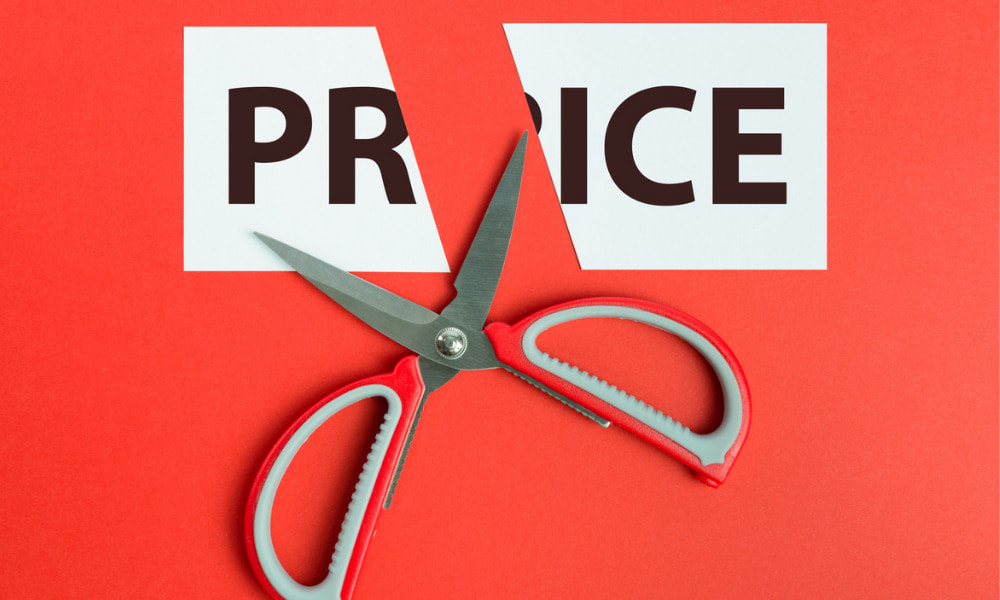|
Is this the end of the seller's market?
Homes in the US are now getting fewer offers after years of surging prices and intense bidding wars. The national bidding war rate fell to a record low of 57.8% in May, down from 60.9% the previous month and the pandemic high of 68.8% a year ago, according to Redfin’s latest report. The typical home in a bidding war received 5.3 offers in May compared to 6.8 in April and 7.4 in May 2021. The May drop marks the fourth consecutive monthly decline and signals a cooling down in homebuyer competition due to surging mortgage rates and home prices. Redfin economists expect the bidding-war rate to fall below 50% by the end of the year. Offers also aren’t coming in as high above the list price as before, according to Nashville Redfin agent Jennifer Bowers. “I recently listed a three-bedroom, three-bathroom home in a super cute neighborhood for $399,900. It ended up going under contract for $12,000 above the list price with an inspection, whereas three months ago, the buyer probably would have paid $60,000 over asking and waived the inspection,” Bowers said. Despite the cooldown, townhouses are still hot commodities and are more likely than any other properties to encounter competition. Townhouses have a bidding war rate of 66.6%, followed by single-family homes with 61.6%, multifamily properties with 58.2%, and condos/co-ops with 54.7%. “Some homebuyers have sought out townhouses because they’ve been priced out of the market for single-family homes. The typical home that went under contract in March was 1,720 square feet, down 1.8% from 1,751 square feet a year earlier,” Redfin said in its report.
0 Comments
Wavering demand allows price appreciation to ease, says Zillow.
Rising interest rates and house prices have made mortgages less affordable now than at any time since 2007. According to Zillow’s latest market report, this has caused housing demand to waver and price appreciation to ease. “Mortgage rates took an unprecedented leap skyward over the past two weeks and quickly multiplied housing costs as they rose,” said Zillow economist Nicole Bachaud. “We are already seeing signs of waning demand, and expect these recent rate hikes to quicken the market’s needed rebalancing. While shoppers will likely experience less competition for homes than the frenzied recent months, their purchasing power has dwindled.” The Zillow report said that the most significant hurdle to housing affordability is the widening gap between incomes and mortgage costs. Based on the company’s data from April, monthly payments are already taking up 28% of homeowners’ monthly income, just below the 30% threshold for what is considered a cost burden. With mortgage rates having surged beyond April’s average, this share is likely “at or very near 30% already.” In fact, even as rent prices ballooned since the start of 2021, mortgage payments are still more expensive in most of the US. According to Zillow, a typical rent payment in May ran higher than a mortgage payment in only five of the country’s 50 largest metros. In 2019, rent was more expensive than mortgage payments in 28 of 50 metros. The report also noted that home values have begun to turn a corner, with May seeing a slightly slower pace of annual growth at 20.7%, down from 20.9% in April. According to Zillow, this signals the possibility of the market having passed an inflection point for home values between April and May. “Arriving in the middle of the spring selling season, this deceleration is a clear signal that buyers are dialing back their demand for homes in the face of daunting affordability challenges,” said Jeff Tucker, senior economist at Zillow. House sales have also shown signs of slowing down, with Zillow reporting that the number of for-sale listings that went under contract in May decreased by nearly 20% from 2021, when activity was at a four-year peak, and 2% from 2019. The median time on market for new listings was found to be just seven days, holding steady from April and even with last May. The share of listings with a price cut has gone up as well, rising to 11.5% in May from a recent low of 8.5% in February. The inventory of for-sale listings has been steadily climbing, sitting at just 14.2% below the level reported last year and 50% below the level in 2019. ATTOM names areas with highest concentration of at-risk counties. A number of housing markets around the US were found to be especially vulnerable to declines based on home affordability, underwater mortgages, foreclosures, and unemployment, according to data from ATTOM’s special housing risk report. Based on recorded patterns for the first quarter of 2022, ATTOM found that New Jersey, Illinois and California had 34 of the 50 counties most vulnerable to potential declines. The Chicago area had eight of these 50 counties and six were near New York City. Ten of the counties on the list were scattered across northern, central, and southern California. The rest of the 50 most vulnerable counties in ATTOM’s report were along the East Coast and the Midwest, including three in Cleveland, OH, three in Philadelphia, PA, and two in Delaware. Areas in the South, meanwhile, had the highest concentration of markets least vulnerable to housing market declines. “While the housing market has been exceptionally strong over the past few years, that doesn’t mean there aren’t areas of potential vulnerability if economic conditions continue to weaken,” said Rick Sharga, executive vice president of market intelligence at ATTOM. “Housing markets with poor affordability and relatively high rates of unemployment, underwater loans, and foreclosure activity could be at risk if we enter a recession or even face a more modest downturn.” ATTOM determined its rankings based on the percentage of homes facing possible foreclosure, the portion with mortgage balances exceeding estimated property values, the percentage of average local income required to cover home ownership expenses, and local unemployment rates. “The housing market has been one of the strongest components of the US economy since the onset of the COVID-19 pandemic,” added Sharga. “But Federal Reserve actions aimed at bringing inflation down from its 41-year high are having an immediate impact on home affordability, sales, and pricing. Whether the Fed can execute a relatively soft landing, or inadvertently steers the economy into a recession will determine the fate of the housing market over the next 12-18 months.” Surge in mortgage rates have stifled demand.
Sales of previously owned US homes fell for a fourth month in May, receding to the lowest level in nearly two years and underscoring how high prices and a surge in mortgage rates have stifled demand. Contract closings decreased 3.4% in May from the prior month to an annualized 5.41 million, the weakest since June 2020, figures from the National Association of Realtors showed Tuesday. The median forecast in a Bloomberg survey of economists called for 5.4 million. The Federal Reserve is aggressively raising interest rates in an effort to tame the fastest inflation in four decades. That’s driven up mortgage rates to levels not seen since 2008. At the same time, home prices continue to rise, quashing affordability for potential buyers across the country. “Further sales declines should be expected in the upcoming months given housing affordability challenges from the sharp rise in mortgage rates this year,” Lawrence Yun, NAR’s chief economist, said in a statement. “Nonetheless, homes priced appropriately are selling quickly and inventory levels still need to rise substantially – almost doubling – to cool home price appreciation and provide more options for home buyers.” The number of homes for sale fell from a year ago, to 1.16 million. At the current sales pace it would take 2.6 months to sell all the homes on the market. While historically low, that marked the fourth straight month of improvement in the months supply. Realtors see anything below five months of supply as a sign of a tight market. The median selling price rose 14.8% from a year earlier, to a record $407,600. First-time buyers accounted for 27% of US sales last month, down from 31% a year ago, and underscoring the affordability challenges that have been pricing many Americans out of the market. The Realtors group noted that sales are primarily occurring in the upper end of the market. Cash sales represented 25% of all transactions in May, up from 23% in the same month last year. Investors, who typically buy in cash and are therefore less sensitive to mortgage rates, made up 16% of the market. Digging deeper
It is trimming prices and offering incentives.
Lennar Corp. has started trimming prices and offering buyer incentives in some areas of the US to bolster sales in a cooling housing market. Rapidly rising mortgage rates and economic headwinds have depressed new orders and buyer traffic in June and increased deal cancellations, the builder said on a call with analysts Tuesday. For now, Lennar is sticking to its earlier forecast for deliveries of about 68,000 homes in its full fiscal year. The catch is that, with demand now starting to wane after the pandemic boom, “current attempts at guidance are tantamount to ‘guessing’ and not ‘guiding,’” executive chairman Stuart Miller said in the company’s earnings statement. He warned about the slowdown already underway, calling it a “complicated moment in the market.” Shares of the Miami-based builder rose after it beat expectations for orders and profit margins in the quarter through May -- a period when buyers were still rushing to lock in deals. But “the weight of a rapid doubling of interest rates over six months, together with accelerated price appreciation, began to drive buyers in many markets to pause and reconsider,” Miller said in the statement. “We began to see these effects after quarter end.” Seven regions had significant slowdowns this month, Lennar said. They were: Raleigh, North Carolina; Minnesota; Austin, Texas; Los Angeles, the Central Valley and Sacramento in California; and Seattle. The company increased incentives, such as mortgage rate “buy-downs,” and lowered prices in some subdivisions to boost demand. Lennar reported that purchase contracts for the three months through May rose 4% from a year earlier to 17,792, beating analyst estimates. The gross margin on home sales jumped to 29.5% from 26.1% in its previous fiscal second quarter. The shares climbed 2.4% to $66.15 at 2:43 p.m. New York time. The S&P 500 index gained 2.6%. Rough seas Homebuilders are facing rough seas ahead with mortgage rates that have soared at the fastest rate in more than 50 years of record-keeping, according to data from Freddie Mac. The Federal Reserve, in its efforts to tamp down rampant inflation, is managing to cool the overheated housing market, and Lennar says it’s well-positioned to maintain its sales in many regions. Lennar’s quarterly results were “impressive and highlight the company’s execution and production-oriented focus, which could support share gains in a declining market,” said Bloomberg Intelligence analyst Drew Reading. Yet while the shares may rise initially, “investors may not be willing to underwrite any near-term positives given the acknowledgment of slowing demand and a less-favorable pricing environment which will likely see an increase in incentives that could also pressure outsized margins,” Reading said. Supply chain One thing that may help builders is that challenges in getting materials appear to be easing. For Lennar, the time it took to build a house in the quarter increased “only slightly sequentially,” said Jon Jaffe, co-chief executive officer, a sign that the supply-chain issues that have plagued the industry have started to subside. Lennar and other builders will need to manage the effects rising interest rates will have on demand, and that may include having to drop prices to lure in buyers. “The Fed’s stated determination to curtail inflation through interest rate increases and quantitative tightening have begun to have the desired effect of slowing sales in some markets and stalling price increases across the country,” Miller said. “While we believe that there remains a significant shortage of dwellings, and especially workforce housing, in the United States, the relationship between price and interest rates is going through a rebalance.” It is trimming prices and offering incentives.
Lennar Corp. has started trimming prices and offering buyer incentives in some areas of the US to bolster sales in a cooling housing market. Rapidly rising mortgage rates and economic headwinds have depressed new orders and buyer traffic in June and increased deal cancellations, the builder said on a call with analysts Tuesday. For now, Lennar is sticking to its earlier forecast for deliveries of about 68,000 homes in its full fiscal year. The catch is that, with demand now starting to wane after the pandemic boom, “current attempts at guidance are tantamount to ‘guessing’ and not ‘guiding,’” executive chairman Stuart Miller said in the company’s earnings statement. He warned about the slowdown already underway, calling it a “complicated moment in the market.” Shares of the Miami-based builder rose after it beat expectations for orders and profit margins in the quarter through May -- a period when buyers were still rushing to lock in deals. But “the weight of a rapid doubling of interest rates over six months, together with accelerated price appreciation, began to drive buyers in many markets to pause and reconsider,” Miller said in the statement. “We began to see these effects after quarter end.” Seven regions had significant slowdowns this month, Lennar said. They were: Raleigh, North Carolina; Minnesota; Austin, Texas; Los Angeles, the Central Valley and Sacramento in California; and Seattle. The company increased incentives, such as mortgage rate “buy-downs,” and lowered prices in some subdivisions to boost demand. Lennar reported that purchase contracts for the three months through May rose 4% from a year earlier to 17,792, beating analyst estimates. The gross margin on home sales jumped to 29.5% from 26.1% in its previous fiscal second quarter. The shares climbed 2.4% to $66.15 at 2:43 p.m. New York time. The S&P 500 index gained 2.6%. Rough seasHomebuilders are facing rough seas ahead with mortgage rates that have soared at the fastest rate in more than 50 years of record-keeping, according to data from Freddie Mac. The Federal Reserve, in its efforts to tamp down rampant inflation, is managing to cool the overheated housing market, and Lennar says it’s well-positioned to maintain its sales in many regions. Lennar’s quarterly results were “impressive and highlight the company’s execution and production-oriented focus, which could support share gains in a declining market,” said Bloomberg Intelligence analyst Drew Reading. Yet while the shares may rise initially, “investors may not be willing to underwrite any near-term positives given the acknowledgment of slowing demand and a less-favorable pricing environment which will likely see an increase in incentives that could also pressure outsized margins,” Reading said. Supply chainOne thing that may help builders is that challenges in getting materials appear to be easing. For Lennar, the time it took to build a house in the quarter increased “only slightly sequentially,” said Jon Jaffe, co-chief executive officer, a sign that the supply-chain issues that have plagued the industry have started to subside. Lennar and other builders will need to manage the effects rising interest rates will have on demand, and that may include having to drop prices to lure in buyers. “The Fed’s stated determination to curtail inflation through interest rate increases and quantitative tightening have begun to have the desired effect of slowing sales in some markets and stalling price increases across the country,” Miller said. “While we believe that there remains a significant shortage of dwellings, and especially workforce housing, in the United States, the relationship between price and interest rates is going through a rebalance.” Latest data from Zillow Group is revealed…
Cities that once saw some of the biggest jumps in home prices during the pandemic now have the largest share of price cuts, according to data compiled by Zillow Group. In May, the proportion of real estate listings with lower prices increased by an average of 11.5% in all 50 of the largest US metropolitan markets tracked by the real estate company this May, up from 8.2% a year ago. The share of lower listing prices rose the fastest in real estate hotspots like Salt Lake City, Las Vegas, and Sacramento, California. The recent leap in borrowing costs – driven by the Federal Reserve’s interest rate hikes – has discouraged buyers and started to cool markets, Bloomberg reported. Among the same 50 metros in Zillow’s data, 32 reported a price decline in more than 10% of listings. In eight cities, the share has jumped by at least 5% over the past year. Rate hikes and rising home prices have pushed the median mortgage application payment up by $513 in the first five months of the year, according to data compiled by the Mortgage Bankers Association, and hit $1,897 in May. “The ongoing affordability hit of higher home prices and fast-rising mortgage rates led to a slowdown in purchase applications in May,” MBA associate vice president of housing economics Edward Seiler said in a statement last week. “Inflationary pressures and rates above 5% are both headwinds for the housing market in the coming months.” Homebuyers are facing a dilemma.
Homebuyer affordability conditions in the US remained relatively unchanged in May, but an inevitable market slowdown is on the horizon, according to the Mortgage Bankers Association. The median mortgage application payment increased slightly to $1,897 in May from $1,889 in April, data from MBA’s weekly survey showed. The uptick signals a higher mortgage payment to income ratio (PIR) and worsening borrower affordability. “The ongoing affordability hit of higher home prices and fast-rising mortgage rates led to a slowdown in purchase applications in May. While the median principal and interest payment only increased $8 from April, a typical borrower is paying $514 more through the first five months of 2022 – a jump of 37.1%,” said Edward Seiler, MBA’s associate vice president of housing economics, and executive director of Research Institute for Housing America. The national Purchase Applications Payment Index (PAPI), which measures how new monthly mortgage payments vary across time relative to income, inched up four basis points to 163.4 in May from 162.8 in April. This means payments on new mortgages take up a larger share of a typical person’s income. However, the index was 35.5% higher than the May 2021 reading of 120.6. “Inflationary pressures and rates above 5% are both headwinds for the housing market in the coming months. MBA’s new forecast anticipates that sales of new and existing homes will fall below 2021 levels,” said Seiler. But as one expert commented, "some may be taking a more 'wait-and-see' stance"
US housing starts posted a second straight monthly drop in May, highlighting the impact of rising mortgage rates and persistent supply chain disruptions. The Census Bureau reported Thursday that new residential construction projects plunged 14.4% in May to a seasonally adjusted annual rate of 1.55 million units. Last month’s reading is below the upwardly revised April reading of 1.81 million and below last year’s rate of 1.61 million. “Housing starts decreased in May for the second month in a row, as mortgage rates increased to above 5% and inflation continued to impact consumer spending,” said Kelly Mangold, principal at RCLCO Real Estate Consulting. “Uncertainty around quickly changing economic conditions has caused sentiment in the building industry to falter, and housing starts slowed in reaction to these factors, as well as in light of persistent supply chain issues.” Within the overall construction figure, single-family starts fell 9.2% to a 1.05 million annualized rate. The multifamily sector, which includes apartment buildings and condos, saw a staggering 23.7% decline to an annualized 498,000 pace. “Single-family home building is slowing as the impacts of higher interest rates reduce housing affordability,” said Jerry Konter, chairman of the National Association of Home Builders (NAHB). “Moreover, construction costs continue to rise, with residential construction materials up 19% from a year ago. As the market weakens due to cyclical factors, the long-term housing deficit will persist and continue to frustrate prospective renters and home buyers.” In further signs that the housing market is weakening, NAHB chief economist Robert Dietz noted that single-family permits are down 2.5% on a year-to-date basis, and home builder confidence has declined for the last six months. Meanwhile, housing completions are on the rise due to the acceleration in construction activity in recent quarters, up 9.1% month over month to a seasonally adjusted rate of 1.47 million. Single-family completions increased 8.5% to 1.04 million, and multifamily completions were 417,000 as inventories start to recover. Taking other market factors into consideration, Mangold said: “The job market continues to perform strongly, and millennials continue to move into family-formation years, indicating that there is likely still pent-up demand for housing – though some may be taking a more ‘wait-and-see’ stance until conditions settle down.” "We've seen rate/term refinance activity essentially evaporate, and cash-out activity is now suffering as well".
Overall rate lock volume fell 4.8% month over month in May as the housing market continues to struggle under the weight of significantly higher rates. “At the start of May, it seemed mortgage interest rates would continue their upward climb and, indeed, rates did rise above 5.5% before pulling back some 20 basis points,” said Scott Happ, president of Optimal Blue, a division of Black Knight. “Ultimately, our OBMMI daily interest rate tracker showed 30-year conforming offerings finishing the month at 5.34%, down seven basis points from last month. Still, despite this plateau in rates, rate lock volume continued to slide in May, with declines seen across all loan purposes.” Mortgage origination data from Black Knight showed that rate/term refinance lending activity posted a staggering 90% year-over-year decline in May, while cash-out refinance locks plunged 42.2% from a year ago. This brings the high-quality refinance candidate population to approximately 472,000 – the smallest this population has been since at least 2000. “We’ve seen rate/term refinance activity essentially evaporate, and cash-out activity is now suffering as well,” Happ said. The combined decline in refinance locks pushed the refi share of the market down to just 18%, the lowest point Optimal Blue has recorded since at least January 2018. Meanwhile, purchase lock volumes are holding up despite a 2.3% drop from the previous month. Purchase volumes are now driving 82% of all origination activity, according to Happ. “Lenders are now more reliant on the purchase market for origination volumes than they have been in 20 years,” he said. “Meanwhile, the trifecta of low inventory, high prices and climbing rates that have created the least affordable housing market in 16 years continues to create headwinds for precisely that segment.” Average credit scores were also down in May, led by another steep decline in cash-out refi credit scores, which fell below 700 on average, down 20 basis points from the past quarter and 33 points from last year. |
|
- iMove Chicago
- Real Estate School
-
Laws
-
CRLTO
>
- 5-12-010 Title, Purpose And Scope.
- 5-12-020 Exclusions.
- 5-12-030 Definitions.
- 5-12-040 Tenant Responsibilities.
- 5-12-050 Landlord’s Right Of Access.
- 5-12-060 Remedies For Improper Denial Of Access.
- 5-12-070 Landlord’s Responsibility To Maintain.
- 5-12-080 Security Deposits.
- 5-12-081 Interest Rate On Security Deposits.
- 5-12-082 Interest Rate Notification.
- 5-12-090 Identification Of Owner And Agents.
- 5-12-095 Tenants’ Notification of Foreclosure Action.
- 5-12-100 Notice Of Conditions Affecting Habitability.
- 5-12-110 Tenant Remedies.
- 5-12-120 Subleases.
- 5-12-130 Landlord Remedies.
- 5-12-140 Rental Agreement.
- 5-12-150 Prohibition On Retaliatory Conduct By Landlord.
- 5-12-160 Prohibition On Interruption Of Tenant Occupancy By Landlord.
- 5-12-170 Summary Of Ordinance Attached To Rental Agreement.
- 5-12-180 Attorney’s Fees.
- 5-12-190 Rights And Remedies Under Other Laws.
- 5-12-200 Severability.
- Illinois Eviction Law (Forcible Entry And Detainer)
- Illinois Security Deposit Return Act
-
CRLTO
>
- Today's Cool Thing
- Social Media











